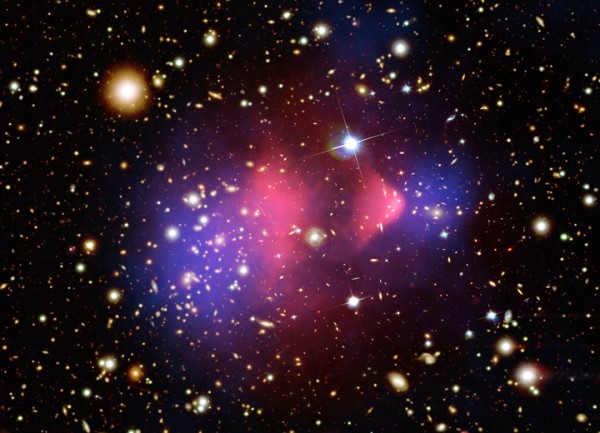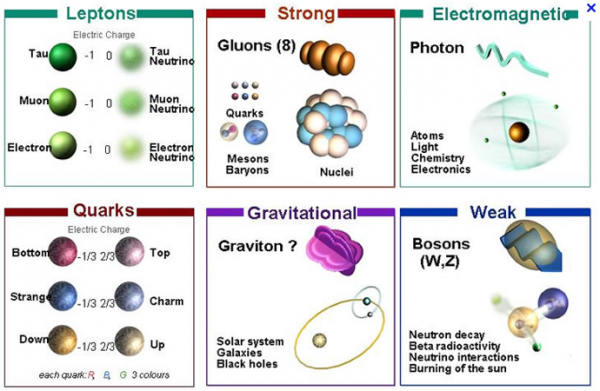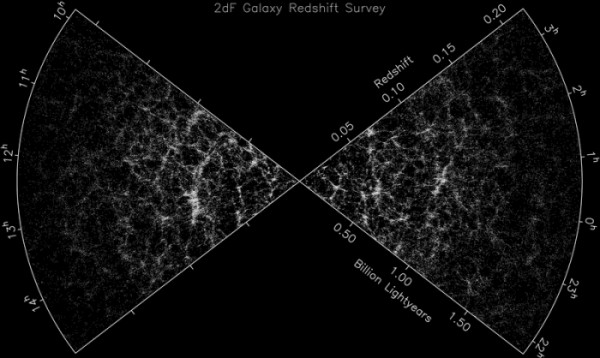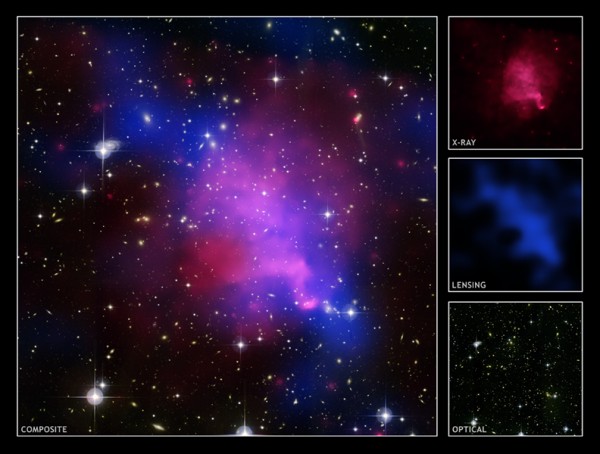"I soon became convinced... that all the theorizing would be empty brain exercise and therefore a waste of time unless one first ascertained what the population of the Universe really consists of." -Fritz Zwicky
You very likely know that there are four fundamental forces in the Universe: gravity, electromagnetism, and the weak and strong nuclear forces. While only some particles experience the nuclear and electromagnetic forces, anything with mass or energy -- which is everything we know of -- is subject to gravity.
The strong nuclear force binds all the nuclei heavier than hydrogen together, the weak force is responsible for radioactive decays and the (incredibly rare) neutrino interactions, but the two you're most familiar with are gravity and electromagnetism. Operating practically everywhere in the Universe, the two of them are the reason you can sit where you are right now as you read this.
The reason that you are safely anchored down to the ground is the force of gravity, accelerating everything at Earth's surface downwards at 9.8 m/s2. But you are (most likely) not accelerating downwards, and that's because your body is composed of these electromagnetically-interacting particles -- atoms -- that the floor/ground/chair pushes back up on you at with an equal and opposite force to gravity.
The net result is that the electromagnetic force and the gravitational force cancel out, and so you remain where you are. When you toss a ball, it makes a parabola, as it gets accelerated down due to gravity. But once the ball hits the ground, it interacts electromagnetically, preventing it from falling through the floor. But imagine, hypothetically, that you instead tossed a neutrino, an object which doesn't interact electromagnetically? What happens then?
Because the neutrino doesn't interact electromagnetically or via the strong force, but does interact gravitationally, it would follow the same parabolic path that the ball did, until it ran into the surface of the Earth. At that moment, while the atoms in the Earth would collide with the atoms in the ball (and that's an electromagnetic interaction), because neutrinos don't interact electromagnetically, the neutrino would simply pass through the Earth's atoms, as though they weren't even there. It would plummet in an orbit -- a nearly perfect ellipse (nearly, because the Earth isn't a point mass concentrated at its very core) -- and would eventually return to its starting point. This is the same way a comet has an elongated, elliptical orbit with the Sun at one focus of the ellipse: due to the force of gravity alone.
The lack of strong and electromagnetic interactions, a vital characteristic of neutrinos, is also a characteristic of dark matter! What would happen if we took two giant blobs of matter -- a mix of dark and normal matter -- and let them go in space? What would happen?
Shown above is the results from such a simulation. In pink is the normal matter, made up of atoms, while in blue is dark matter. Initially, both the dark and normal matter move together, accelerating towards the other blob. When they first collide, the atoms smash into one another, slowing down and heating up! But collisions are electromagnetic interactions, so dark matter doesn't do it. Instead, the dark matter passes right through everything: through the normal matter in its own blob, through the other blob's dark matter, through the other blob's normal matter. So what we should see, shortly after a collision like this between, say two galaxy clusters in space, should be a separation in space between the dark matter (observable through the effect of weak gravitational lensing) and the normal matter (observable through the hot X-ray emissions that should come from the colliding gas).

Image credit: X-ray, Optical, Lensing composite, courtesy NASA / CXC / CfA / M.Markevitch et al. / STScI / Magellan / U. Arizona / ESO WFI / D.Clowe et al.
These colliding clusters -- known as the Bullet Cluster -- strongly support a picture where galaxy clusters are made up predominantly of a large, diffuse halo of dark matter with a much smaller amount of normal matter in the form of collapsed, star-containing structures and gas.
We can then go back to the beginning of the Universe and simulate how galaxies should form in a Universe filled with dark matter, dark energy, and normal matter in the proportions we think are present.

Image credit: V. Springel et al., for the Millenium Simulation, retrieved from alfalfasurvey.wordpress.com.
And we can compare it to the galaxies that are actually there in the observed Universe, and see how well the simulations agree with the data!
The answer is extremely well, of course, but we don't merely rely on a visual inspection. Rather, we do our analysis quantitatively, and see what the best fit cosmological model is to this data. What do we find?
A Universe, dominated by dark energy, where 17% of the matter is normal matter and 83% is dark matter. The "wiggles" you see in the power spectrum, above, come from normal (baryonic / atomic) matter, which would go all the way down to the bottom of the graph were there no dark matter. This is one of the strongest arguments against a Universe without dark matter, and has been made even stronger in recent years by better observations by the Sloan Digital Sky Survey.
But the Bullet Cluster is not the only cosmic smash-up between galaxy clusters in the Universe, although it might be the simplest, earliest-stage one we've observed. Things are much less easy to decipher in, say, cluster Abell 520.
With the X-ray and lensing data clearly more complicated than in the Bullet Cluster, it is difficult to piece together exactly what's going on here. Perhaps this is an intermediate stage in a cluster merger? Perhaps something unusually violent is happening here? Or, spectacularly, perhaps dark matter is not behaving the way all other indicators are pointing?
The above image was released in 2007, and what you want to make sure to do is check that your observational data is solid. So they went back, got to use the Hubble Space Telescope to improve their observations, and got even better data, which was just released a few days ago. What -- in a new set of false-colors -- did they find?
What are we looking at here? From the NASA site itself:
Starlight from galaxies, derived from observations by the Canada-France-Hawaii Telescope, is colored orange. The green-tinted regions show hot gas, as detected by NASA's Chandra X-ray Observatory. The gas is evidence that a collision took place. The blue-colored areas pinpoint the location of most of the mass in the cluster, which is dominated by dark matter.
So in this case, the optical presence of the galaxies (orange), so well-aligned with the dark matter in the Bullet cluster, are independent of both the gas, in green, and the dark / overall matter, dominated by the blue color. Perhaps this is easier to see if we look at each of these components separately.
There's some overlap of the dark matter with the luminous galaxies, which ought to move together with the dark matter, but there's also substantial overlap of the dark matter with the hot gas, which is an unexpected surprise!
Does this mean that dark matter's doing something weird? My first instinct -- mostly because the evidence for the standard theory dark matter is so overwhelming from so many different sources -- is to wonder whether this isn't either a later-stage collision, and/or if there isn't enough cool gas mixed in with the central hot gas to obscure a group of galaxies at the center that are actually there, but behind the gas? (This cosmic catastrophe, after all, is about 2.4 billion light-years away, and in three dimensions.) The jury is still out:
"This result is a puzzle," said astronomer James Jee of the University of California, Davis, leader of the Hubble study. "Dark matter is not behaving as predicted, and it's not obviously clear what is going on. Theories of galaxy formation and dark matter must explain what we are seeing."
If I make a composite of the three separate image components -- luminosity, mass, and X-ray emissions -- without those distracting background galaxies, what do we find?

Something very puzzling is going on here. If this is as young a collision as the Bullet Cluster, it's conceivable that dark matter is doing something very weird. We have very few examples of high-speed galaxy cluster collisions in the Universe, with Abell 520 and the Bullet Cluster being the two best measured ones, and yet they appear -- at first glance -- to be inconsistent with one another!
I'll definitely be following this story to see if there's a resolution, but if it turns out that this is as young a collision as the Bullet Cluster, there are no hiding galaxies, and the current picture of dark matter cannot explain what these galaxy clusters are doing, we may be learning an awful lot more than we bargained for awfully soon. Some are betting that's what will happen; I am by far more cautious, and would still happily bet on the standard picture of dark matter, with perhaps some complex kinematics -- maybe involving multiple mergers -- for the collision. For the time being, I'm content to agree with Ray Sanders, and say that the dark matter core of Abell 520 is mysterious. What's the solution to the mystery? I've made my wager; what's yours?










This post brings a somewhat tangential question to mind, Ethan: Do we know if dark matter experiences weak interactions? Is there any observational evidence one way or the other?
Very good post. One minor correction is that the 4-panel showing the large blobs of dark matter and normal matter are a series of artist's impressions, rather than stills from a simulation. Later on Volker Springel and Glennys Farrar did a simulation, available as a video:
http://www.mpa-garching.mpg.de/~volker/bullet/
Another example of a "clean" system, like the Bullet Cluster, is MACS J0025.4-1222:
http://chandra.harvard.edu/photo/2008/macs/
and another example of a messy system is Abell 2744:
http://chandra.harvard.edu/photo/2011/a2744/
Brian,
At this point, there are only constraints on how much smaller the weak cross-section between dark matter and normal matter is than between neutrinos and normal matter.
The cross-section could be zero, which would mean no weak interactions at all, or it could be very small, which means that dark matter could have a very interesting history dating back to the early Universe, when energies were high and interactions took place frequently.
Dark matter and stars should be very much together, regardless whether recent or older collision with multiple oscillations, so I do not see what you mean with that handwaving about older/multiple collisions. Assuming all red shifts etc worked out and the dark matter is not some foreground patch or whatever mess sometimes happens in observational science, lets suppose for a moment disfavored, âMOND-likeâ explanations. The bullet cluster looks like a symmetric two body collision, but this mysterious one more like a smeared out three body collision (see orange patches). If the grav-lens effects are due to weird MOND-like acceleration/local expansions, it would less surprise that the more symmetrical situation has the stars and lensing effects âcoincidentallyâ still together while the more messy collision has those effects, well, more messy.
BTW, most of the mass of the earth is in its outside radius, so the neutrino really would not make the same ellipse as a comet, but that is perhaps nitpicking.
excuse me for apparently stupid question but there is goes.
on all pictures of observed galaxy there are four sectors - two of them are full of stuff while two are completely black. why is that?
Earth (aka point of view) is in the center of observation field, isn't it?
http://i.imgur.com/VAi4c.png
(sorry for madskillz)
nevermind, i already found something about non-transparent star dust blocking view in those directions.
thanks anyways!
As I understand it, dark matter tends to form diffuse halos around galaxies. Surely there has to be something other than gravity causing this. What prevents dark matter from simply accumulating at the center of galaxies?
Why is it a "girl" in a chair? And in pink, too? Why isn't it just a chair?
Oh how utterly tiresome. Yet again, on the subject of Invisible Dark Matter we encounter from the so-called experts in cosmology a phrase along the lines of:
âThis result is a puzzle," said astronomer James Jee of the University of California, Davis, leader of the Hubble study. "Dark matter is not behaving as predictedâ¦â
How often in the last twenty years or so have we heard this plaintive bleat from those who are supposed to be capable of conducting basic science?
Post epicycle scientists should not try to impose their opinions on how particles should behave in advance of observations made of the particleâs actual bahaviour in the real universe. A scientific theory should be based on observation and derived from those observations, not on advance expectations.
Just as an aside, Iâm aware that Ethan has a visceral hatred of the concept of higher spatial dimensions, such as the ones outlined in the Randall-Sundrum theory, and variants, but if a particle is invisible and undetectable in all aspects except gravitational is that not sufficient to qualify it as a higher spatial dimension particle?
(Note: To clarify, I referred to the post of a year or three ago where Ethan gave odds for and against various scientific ideas. I canât track it down or Iâd link it).
@ 2
I assume you mean the top bullet cluster 4 panel is an artist interpretation.
I assume the bottom Abell 520 4 panel is observation images (i.e neither simulation nor artist)
Ethan
I of course defer to your expertise.
But let me observe and ask a question. To me, a non expert, Abell 520 does not look like a collision; it looks like 3 galaxies that are in orbit around each other. So my question is; what does the dark matter profile of binary galaxies look like compared to Abell 520 and versus the Bullet Cluster. I assume someone has looked at and analyzed the dark matter of binary galaxies.
@8
You say, "if a particle is invisible and undetectable in all aspects except gravitational is that not sufficient to qualify it as a higher spatial dimension particle".
Well I would think that would be one possible interpretation. Of course then, we need to see the details of what exactly mathematically "higher spatial dimension particle" means, e.g. which string theory are we exactly talking about. And of course such a string theory isn't here yet. Personally, (as a non-expert); I think of the graviton as a 4-dimensional glueball composed of four 1-dimensional gluons. In my mind the "hypothetical graviton" is the "primary hypothetical glueball". Hypothetical because not observed. Thus in my mind gravity emerges from the strong force. Now this might sound like something; but without the mathematics I got nothing (yes mathematic detail that works is important)
if a particle is invisible and undetectable in all aspects except gravitational is that not sufficient to qualify it as a higher spatial dimension particle?
No. To clarify: There isn't sufficient ground (AFAIK; it's not my field) to rule out the idea of dark matter particles being in higher spatial dimensions, but there is no particular reason to think that it isn't in the same number of dimensions as ordinary matter.
As for the statement by Dr. Jee that you are criticizing: We have had several tests of what dark matter does, and we have developed a theory that predicts what it should do in other situations. As Ethan has explained in other posts, this theory is currently the only game in town for satisfying the tests it has passed. Jee is saying that this theory is inconsistent with the interpretation of the observations. So either the theory is wrong, or there is a problem with how these observations are interpreted. The latter is not ruled out. As Ethan explains in the post, our telescopes look along a particular line of sight, so if the dark matter and the gas appear to be collocated, it could be that the dark matter is behind the gas. (The dark matter could in principle be in front of the gas as well, but I infer that the lack of foreground satellite galaxies makes that interpretation unlikely.) Gravitational lensing works on the same principle: light from the background object is bent around the foreground object.
Can the concept of an electrical universe explain some of the observations of dark matter, and dark energy?
Why do you think that matter of gas is different to matter of galaxies?
Long long ago nearly everything was gas and later clumped together at locations where DM was more massive (simulations tell us this). Thus also gas has a DM-halo. There is no difference to normal BM.
Why are astronomers so excited about this observation in Bullet- or Abell 520-Clusters?
"There is no difference to normal BM."
should read
"There is no difference to galaxy-BM."
From my layman's point of view, on Abell 520 it looks like two, and possibly three, galactic clusters in a late stage of merging on the left (with little hot gas remaining in-between them), that are about to collide with another large cluster on the right. The dark matter of the older (left) merges has already passed through, forming three to four distinctly separate blobs, including a "leading edge" that is already inseparable from the closest "boundary" of the other (right) cluster. The hot gas of the x-ray indicates very young merging edges of the merged cluster intersecting with the newly encountered cluster.
What happens when dark matter hits a black hole? Or is that just too small of a cross section to have a noticeable effect?
@rusty
As I understand it, normal matter can tend to clump because collisions are not perfectly elastic. Imagine two hydrogen atoms each on opposite sides of a galaxy and located very far away (but subject to the galaxy's gravitational force) and each initially at rest with respect to the galaxy. They will then start accellerating towards the center of a galaxy from opposite directions: if they pass by each other without colliding (and without colliding with any other matter in the galaxy) both will pass right through it and eventually (but only momentarily) come to rest of the opposite side of the galaxy, at the same distance they started at. (A classic "ideal" gravitational potential energy converted to kinetic energy back to gravitational PE, with complete conservation of system energy.)
Now instead imagine that they collide perfectly head on with each other. Some of the energy will be conserved as kinetic energy as the atoms rebound back onto their incoming line of flight, but some will be absorbed by the atoms, bumping the electron into a higher energy state. That energy than can be emitted as a photon as the electron returns to the ground state, said photon (and it's energy) to be lost into the cosmos. Now the atoms, having less kinetic energy than they had just prior to the collision will not make it back to their starting point, but rather will stop (and then reverse) closer to the center of the galaxy.
The net effect is that, because of the loss of energy during the collision, they become (on average) located a bit closer towards the center of the galaxy.
Repeat for billions of years, and/or multiple collisions per pass. The normal matter will tend to clump.
Dark matter is thought not to interact in this way: it doesn't (or doesn't very often) interact with other matter, and so will not (or won't as quickly) tend to clump towards the center of the galaxy.
Anyway, that's an "edjucamated laymans" explanation of why normal matter clumps and dark matters doesn't (at least not as well).
@rusty
One more thing: as I understand it, the loss of energy due to the collision (which gets emitted away by photons) accounts for the x-ray emitting gas left behind at the collision point. A lot of matter (more than is in the galaxies) in a galaxy cluster is in the form of diffuse "gas" of normal matter, and the collision of this gas with the gas from the other cluster is what stops it (or slows it way down relative to the clusters galaxies) at the collision point and the energy absorbed in those collisions is what accounts for the x-ray emissions.
Hmm, post #17 "One more thing" followed a longer post, that apparently got trapped in moderation (but post #17 went up immediately).
@ Alan L.
Talk about tiresome. What do you think scientists are doing if not crafting their hypothesis in order to explain the observations that have been made? Well whatever it is you think they're doing you're wrong, because that's exactly what they're doing.
Or is it that you don't think any theory based on observation could subsequently have observations that don't match expectations based on that theory, and from that infer that hypothesis has preceded observation? In which case you're also wrong.
If your pet theory was so good, it would be able to explain the observations better than DM and succeed on its own merits, and not require trying to submarine other scientists by comparing DM to epicycles or claiming they can't conduct basic science.
Ethan, how would the bullet cluster picture be any different if the excess matter is just a large number of black holes? A black hole can most likely move through a galaxy without a direct hit on anything equally massive, so a galaxy rich in dark holes would give you exactly the same results as dark matter.
@CB
You failed to comprehend what I wrote. I'm not comparing DM to epicycles. There is no doubt that it exists.
My objection is to a common complaint made by far too many scientists that DM does not behave in a manner that accords with their doctrinal beliefs.
@ Alan
So I correctly understood the part where you said they were putting hypothesis before observation and were unable to conduct basic science. Got it. You're still wrong.
There are already quite a few observations of dark matter -- enough that there is indeed little doubt that it exists. Those observations and the proposed explanations create certain expectations. Expectations that this new observation doesn't at first blush appear to match -- though it may eventually once we come to understand the event in question better.
Please point out the part where this isn't good science, or is putting hypothesis before observation (the part where observation came first being an obvious difficulty for that claim). Because we have only made a lot of observations, but not every observation? Because we made an observation that might show our previous hypothesis was wrong or incomplete? So what? These are both normal.
I think the problem here is exemplified by you characterizing the observation that DM may not being doing what we expected as a complaint.
No, wait, it's the characterization of their observation-inspired hypothesis as "doctrinal beliefs". That's the first time I've heard that phrase from someone who wasn't rejecting DM (and/or the rest of physics) outright, so kudos for the new experience. I'm still tempted to think the phrase says more about the speaker's "belief" than anything else.
@22
There is such a full portfolio of consistent "dark matter observations"; that yes, new apparently conflicting evidence does adds to the puzzle.
"Dark matter" scientists do have working hypothesis with predictions; but that is exactly the opposite of being "doctrinaire"; because at root scientists are open for any explanation that will satisfactorily explain the "dark matter observations".
This is probably a stupid question, but how do we know that the gas is not in front or behind of the dark matter?
@Jimmy (26):
...think of redshift of the emission lines of the gas...
No one has mentioned the affects from conservation of angular momentum: if two galaxies collide head on, you get something like the bullet cluster, but if they're offset a bit, then both the stars and dark matter will rotate about the center of gravity of the system. Since the stars and gas will lose speed when passing through each other, they should rotate faster than the dark matter to conserve angular momentum. Therefore, after the collision, the line between the centers of mass of the visible galaxies won't be parallel to the line between the centers of the dark matter distributions. An observer aligned more closely with the line between the dark matter distributions would see something like this image. To test this, it would be necessary to take an accurate enough measurement of the redshifts to determine if there were a rotation. One would also expect to find an X shaped cluster somewhere where the dark matter and stars were moving away in different directions.
Most of you all are way ahead of me in these areas of physics but I was struck by the remark of Alan L "but if a particle is invisible and undetectable in all aspects except gravitational is that not sufficient to qualify it as a higher spatial dimension particle?"
What strikes me about that is the fact that to my mind Alan L is taking normal human vision as a general norm for vision.
It strikes me that if our instrumentation allows us to be aware of dark matter or energy because of its reaction to gravity than the matter is not invisible. As we all know because of the limitations of our eyes we have developed all sorts of devices for seeing what is certainly there despite our human eye limitations.
I could point out that it is not our eyes alone that see but without the brain would in fact not see.
In a manner no doubt similar to the way in which our brain learned to see what our eyes were detecting we have developed instruments to see those wave lengths and particles otherwise "invisible."
So it is with dark matter where we use the gravitational lensing of visible light or of other particles to see dark matter.
Taken that way the "mystery" of dark matter is not so mysterious. It is simply matter that outside of being discoverable because it has mass and therefore a gravitational field, as does everything else in the universe, it seems to have no other characteristics so common to all other matter thus seems to be mysteriously "invisible."
The dark matter "mystery," to me, therefore boils down to the question of what would be the attributes of matter in such a state; that outside of mass it is otherwise undetectable. Further, since it appears to be the bulk of all matter in the universe, how and when in relation to the big bang was it formed.
Or is the real answer here simply an attribute of our vision oriented chauvinism.
Jack Jersawitz
404-892-1238
bigjackjj@yahoo.com
@ Jack Jersawitz
That's a good point that being able to detect something via gravity means that in a sense it is not invisible.
It's also a good point about 'vision bias' -- Alan L is saying DM is invisible in all respects except gravitational, when right now we don't actually know if that is true. It is clearly invisible to electromagnetism, which is our only method of direct remote detection, but that is not the only other way matter can make itself known.
Take the neutrino for example. It is, like DM, completely invisible to the electromagnetic spectrum. However it does interact through the Weak Force, and so every so often a neutrino passing through the earth hits one of our detectors.
So it's not even necessarily the case that DM is that much more exotic than something verified experimentally in 1956.
If dark matter responds to gravity only, why has it staid in a defuse halo and not clump in more discrete forms like ordinary matter does?
I'm curious. What properties/values are entered for DM and/or DE in those computer simulations that seem to give almost identical structure of Universe as observed ones do?
Since gravity/mass plays a crucial role, I would expect that some value must be ascribed in the computer model. But we don't know those values in real world (for DM and DE). Is it a case of fine-tuning the simulation to achieve the image that is close to observation?